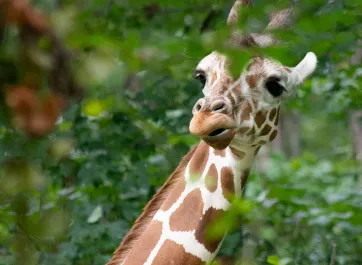Conservation biologists have recently raised alarm after noting a 40% decline in Africa’s giraffe population over the past three decades. Moreover, genetic evidence suggests that what was previously thought of as one widespread species may, in fact, consist of four, or perhaps as many as eight, different giraffe species. Several of these new species are at grave risk of extinction if threats persist and thus in urgent need of conservation attention. The North Carolina Zoo is helping to protect giraffes in Tanzania by assessing their population health and helping rangers on the ground reduce poaching. The Zoo is also actively involved in investigating a mysterious skin disease that, as of yet, has no known cure.
More than One Species
Giraffes were previously thought to be relatively common species that were widespread across Sub-Saharan Africa. Consequently, this charismatic species has received little attention over the years. But concerns about the dramatic 40% population decline over the past three decades - driven primarily by habitat loss and poaching - have led several biologists to give giraffe conservation another look. One surprising finding from genetic studies has shown that giraffes may, in fact, consist of four, or perhaps as many as eight, different species. The recognition that multiple giraffe species exist, in effect, divided the previously one large and widespread giraffe population into several small and isolated species, with several species facing extinction within decades if threats persist.
A Mysterious Skin Disease
In addition to poaching and habitat loss, fieldwork in southern Tanzania has also shown that the region’s giraffes may be impacted by a mysterious skin disease that causes lesions on an affected animal’s neck and legs. While some opportunistic observations suggest that the disease may weaken animals, making them more vulnerable to lion predation, we really don’t know much about this disease. Given that as many as 80% of animals may be affected in some giraffe populations, there is an urgency to find what causes this disease, what environmental factors increase infection rates, how the disease is affecting giraffe survival, and how it can be treated.
Conserving Tanzania’s Giraffes
Several zoos have banded together as part of a new Giraffe SAFE (Saving Animals from Extinction) program established through the Association of Zoos and Aquariums in 2016. The North Carolina Zoo was asked to assist with efforts focused in Tanzania, where we have previous experience with vulture conservation initiatives. In partnership with the Giraffe Conservation Fund, the Zoo developed a research project for Nyerere National Park (formerly Selous Game Reserve) and Ruaha National Park to improve our understanding of giraffe population status and trends, as well as disease progression over time. The goal of the project is to use these data to develop and implement sustainable and well-informed conservation strategies.
Partners: Giraffe Conservation Fund, Tanzanian National Parks (TANAPA), Wildlife Connection, Tanzanian Wildlife Research Institute (TAWIRI), Tanzania Wildlife Authority (TAWA)



